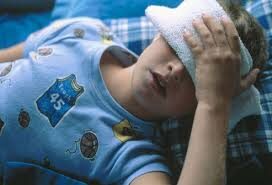 Headaches are common and just like adults, children can experience different types of headaches, including migraines in children. Migraine is a moderate to severe throbbing, pounding or pulsating pain or discomfort felt in the head. Headaches of this type usually last from two to four hours and may occur several times a month. Moreover, these migraines can disrupt daily activities and do not disappear and come back during course of migraine. Migraines can be genetic, thus some children may be more prone to migraines as compared to others. However, migraines in children are more common in boys than girls until menarche.
Headaches are common and just like adults, children can experience different types of headaches, including migraines in children. Migraine is a moderate to severe throbbing, pounding or pulsating pain or discomfort felt in the head. Headaches of this type usually last from two to four hours and may occur several times a month. Moreover, these migraines can disrupt daily activities and do not disappear and come back during course of migraine. Migraines can be genetic, thus some children may be more prone to migraines as compared to others. However, migraines in children are more common in boys than girls until menarche.
How is Migraine in Children Different from Migraine in Adults
Migraines in children are generally different from those experiences by adults, hence it is commonly underdiagnosed.
- Pain usually affects whole head instead of just one side
- Shorter attacks, generally a few hours, but may last up to 30 minutes only
- Abrupt onset but peak of pain lasts only less than 15 minutes
- One symptom is frequent motion sickness
- No head pain but only abdominal pain
- Even after migraine disappears, the child may feel sick, which can sometimes even feel worse than migraine
Types of Migraine in Children
It may be difficult to diagnose children with migraine due to the different types of migraines.
- Common migraine (migraine without aura)
- Most common type
- Classic migraine (migraine with aura)
- Often begins late in the afternoon
- Complicated migraine (supplemented by neurological symptoms)
- Ophthalmoplegic migraine
- Leads to abnormal paralysis of the eye’s motor nerves and dilated pupils
- Ophthalmoplegic migraine
- Hemiplegic migraine
- One side of the body is in a weaker state
- Basilar artery migraine
- Pain felt at the base of the skull, accompanied by vertigo
- Confusional migraine
- Characterized by momentary period of confusion and language problems
Triggers of Migraine in Children
Similar to adults, many things can trigger migraine in children and they usually vary per child. Some of the most common factors that trigger migraine in children are the following:
- Stress
- Lack of sleep
- Diet and or change in regular eating patterns
- Caffeine withdrawal
- Travel
- Menstruation
- Medications
Symptoms of Migraine in Children
Symptoms vary from child to child and the type of migraine. The greatest characteristic of migraines is the throbbing, pulsating pain in the head. For children, it frequently affects both sides of the head.
- Common migraine
- Prodome: characterized by change in appetite, mood, thirst, arousal
- May last as short as 30 minutes to as long as 48 hours
- Sensitivity to light, odors and soungs
- Postdrome: deep fatigue and depression
- Classic migraine
- Presence of aura or visual symptoms such as, bright flashing lights or dots, blind spots, wavy or jagged lines
- Aura may imply brainstem or cortical dysfunction
- Other symptoms
- Nausea and vomiting
- Loss of appetite
- Abdominal pain
- Paleness of the skin
- Irritability
Management of Migraine in Children
It is generally recommended to identify what trigger migraines in children. Prevention is better than having to treat a symptom. However, when symptoms begin to manifest, treat these symptoms to prevent the attack from further developing.
- Sleep may improve the child’s condition even without treatment.
- Not all over-the-counter medications can be given to children. Acetaminophen and ibuprofen may be given to children to relieve them of migraine. However, talk to the doctors first before giving aspirin, as it is associated with Reye’s syndrome, a potentially fatal condition, in children.
- Advise the child to drink plenty of fluids, especially water, to avoid dehydration. An ice pack may be placed on the forehead.
Disclaimer: The information provided above does not substitute for medical advice or diagnosis. To learn about more about how to treat migraines in children and in adults, register to join the nearest first aid training available.

